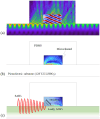Enhanced Micromixing Using Surface Acoustic Wave Devices: Fundamentals, Designs, and Applications
- PMID: 40572339
- PMCID: PMC12195571
- DOI: 10.3390/mi16060619
Enhanced Micromixing Using Surface Acoustic Wave Devices: Fundamentals, Designs, and Applications
Abstract
Microfluidics-based mixing methods have attracted increasing attention due to their great potential in bio-related and material science fields. The combination of acoustics and microfluidics, called acoustofluidics, has been shown to be a promising tool for precise manipulation of microfluids and micro-objects. In general, achieving robust mixing performance in an efficient and simple manner is crucial for microfluidics-based on-chip devices. When surface acoustic waves (SAWs) are introduced into microfluidic devices, the acoustic field can drive highly controllable acoustic streaming flows through acoustofluidic interactions with micro-solid structures, which have the advantages of label-free operation, flexible control, contactless force, fast-response kinetics, and good biocompatibility. Therefore, the design and application of various SAW micromixers have been demonstrated. Herein, we present a comprehensive overview of the latest research and development of SAW-based micromixers. Specifically, we discuss the design principles and underlying physics of SAW-based acoustic micromixing, summarize the distinct types of existing SAW micromixers, and highlight established applications of SAW micromixing technology in chemical synthesis, nanoparticle fabrication, cell culture, biochemical analysis, and cell lysis. Finally, we present current challenges and some perspectives to motivate further research in this area. The purpose of this work is to provide an in-depth understanding of SAW micromixers and inspire readers who are interested in making some innovations in this research field.
Keywords: acoustic mixing; interdigital transducer; microfluidics; micromixer; surface acoustic wave.
Conflict of interest statement
The author declares no conflicts of interest.
Figures







References
Publication types
Grants and funding
LinkOut - more resources
Full Text Sources

